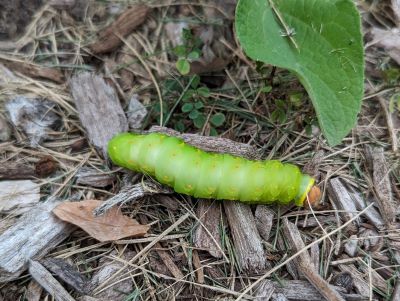
Good Natured: Caterpillar Discoveries
On the surface, it might seem as though a polyphemus caterpillar's daily life is pretty mundane. As the larva of one of our area's largest moths, its primary activities are feeding and, ah, voiding, and can be summarized thusly:
Munch, munch, munch.
Crunch, crunch, crunch.
Plop, plop, plop.
Repeat.
But as Good Natured readers, you know there's got to be more to the story. You betcha there is!
I'll start by saying the inspiration for these coming details came a couple weeks ago as my friend Bonnie and I were searching, unsuccessfully, for a neighborhood butternut tree (Juglans cinerea, also known as white walnut). We were at Baker Field Park in St. Charles, having just inspected what turned out to be an Amur cork tree, when we happened to notice a green caterpillar descending the trunk of a nearby oak.
As caterpillars go, this one was large—about the size of a breakfast sausage—and moving along pretty quickly. Well, for a caterpillar.
Sausage-sized larvae aren't all that common in our area, and the fact that this caterpillar had been dining on oak leaves made the list of contenders even smaller. It had to be one of four giant silkmoth species seen around the TriCities area.
It lacked the bells and whistles (festive red, yellow and blue knobs) of a cecropia, nor did it display the long hairs and yellow spikes of the imperial. With no yellow line traversing its sides, which would have indicated luna, we were left with one diagnosis…which you probably saw coming: Polyphemus.
Antheraea polyphemus gets its specific name from one of the cyclops in Homer's The Odyssey. While the caterpillar's eyes are indistinct, the moth into which it develops features two prominent blue and yellow markings on its hindwings. These, apparently, reminded early taxonomists of the eye in the center of mean, scary Polyphemus's forehead and function as predator deterrents. When the moth lifts its forewings, the eyes appear and, Boo! The would-be predator is startled into inaction or—if it dares--takes a swipe at the “eyes" but spares the more important body parts.
Getting back to the caterpillar at hand, Bonnie and I took stock of the surrounding area and realized that this particular fat cat didn't have a promising future. At this life stage, the larva was leaving its host tree so that it could find a peaceful pile of leaves in which to pupate. But Baker Field Park frankly didn't have much to offer.
The small neighborhood park currently is undergoing some pretty extensive renovations, and the lawn surrounding the tree was criss-crossed with the tracks of trucks, tractors and skid steers. Plus the mowers would be coming soon. So it was that Bonnie and I came up with a Plan B for little Poly.
We took an empty lunch sack from my car and added a couple handfuls of dried leaves before placing the future moth inside. Later, at my house, I put the sack in a kitchen cabinet to make sure the visiting cat didn't get eaten by the resident cat, Jimmy.
The next morning, I have to say, was a little bit like Christmas. I approached the lunch bag much the way I would a Christmas stocking, somewhat breathless in anticipation of what might be inside.
One corner of the sack looked wet, which was a promising sign. Caterpillars need to empty their gut one last time before transitioning to the pupal stage.
I used a pair of scissors to carefully cut around the lower portion of the bag, and what to my wondering eyes should appear but a beautiful silken cocoon, adorned with a few of the leaves we'd added.
Now granted, I knew what to look for. And I was looking into a lunch sack, for heaven's sake. But I couldn't help but notice about how wondrously camouflaged that cocoon was. I also couldn't help but wonder, how many of these extraordinary creatures get obliterated by rakes, mowers and leaf blowers. Talk about a great reason to leave the leaves!
As for this specific caterpillar, even though it's away from the busy park, it definitely isn't out of the woods. There's a chance this fat green sausage is harboring the larva of one of several fly and wasp species known to parasitize polyphemus cat.
We won't know for sure what's going to emerge from that cocoon—a moth, a fly or a wasp--until springtime rolls around. Until then the plan is to keep it in the garage, where the temperatures will stay cool enough to prevent early eclosure—the fancy word for emergence. A mason jar with a screen for a lid will guard against marauding mousies, and a note on my calendar will remind me when it's time to start monitoring the jar.
Until then, I'll bide my time, and keep my eyespots open. 'Tis the season for fun caterpillar discoveries!
Pam Otto is the outreach ambassador for the St. Charles Park District. She can be reached at potto@stcparks.org.

